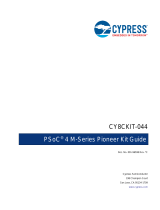1 Functional Description
1.1 Connectors and Jumpers
40 Pin Raspberry Pi GPIO Connector (J1): This connector is used to attach the Pmod HAT to the host Raspberry Pi
and provide access to each of the connector pins. Most of these 40 pins are shared with the Pmod ports. The Pmod
ports are not intended to be used simultaneously with an additional HAT. However, five GPIO pins (22-25 and 27)
are unused by the Pmod HAT Adapter. These pins are available for use by other HATs or as user GPIO. Pmod port
pins are connected to the 40-pin GPIO connector as seen in the Pinout Table Appendix.
External Power Jack (J2): This connector can be used to provide power to the Pmod HAT adapter and the attached
Raspberry PI. See the Power section below for more information.
Pmod Port JA: The first of the three 2×6 Pmod host ports, this port supports SPI and GPIO Pmods.
Pmod Port JB: The second of the three 2×6 Pmod host ports, this port supports SPI and GPIO Pmods, as well as 6-
pin I2C Pmods on the bottom row.
Pmod Port JC: The third of the three 2×6 Pmod host ports, this port supports UART and GPIO Pmods.
Jumpers JP1 & JP2: These jumpers enable pullup resistors for the Pmod Port JB I2C pins when shorted.
Jumper JP3: This jumper enables writing to the onboard EEPROM containing the device tree fragment and other
information used to configure the Raspberry Pi OS and drivers. Shorting this jumper is for advanced use only. See
the Raspberry Pi HAT Introduction for more details.
1.2 Power
The Pmod HAT Adapter can be powered either from the Raspberry Pi through the 40-pin GPIO connector's two 5V
pins, or from an external 5V supply through the power jack. If an external supply is used, it must be able to provide
1.3 Amps of current. In addition, each Pmod GPIO pin can supply at most 16mA of current.
Important!
Make sure to never connect both the Pmod HAT Adapter and Raspberry Pi's power supplies at the same
time. When changing power supplies, make sure to first fully disconnect the original supply
2 Software Support
RS Components has produced the DesignSpark Pmod Library which can be used with a Raspberry Pi to control
Pmods through the Pmod HAT Adapter using the Python programming language. Documentation and downloads
for this library can be found at the following locations:
• Python library at Python.org.
• Documentation and installation instructions on Readthedocs.io.
• Source code at Github.com.
• RS Components Stock No 1448419




